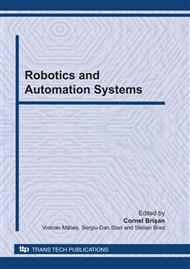[1]
V.S. Bottazzi and J.F.C. Fonseca: Off-line Robot Programming Framework, in: 2005 Joint International Conference on Autonomic and Autonomous Systems and International Conference on Networking and Services, pp.441-446, ISBN: 0-7695-2725-6 (2005).
DOI: 10.1109/icas-icns.2005.70
Google Scholar
[2]
C. Connolly: Technology and Applications of ABB RobotStudio, in: Industrial Robot, Vol. 36(6), pp.540-545 (2009).
DOI: 10.1108/01439910910994605
Google Scholar
[3]
S. Brad: Complex System Design Technique, in: International Journal of Production Research, ISSN: 0020-7543, vol. 46(21), pp.5979-6008 (2008).
DOI: 10.1080/00207540701361475
Google Scholar
[4]
J. Rossmann, M. Schluse and T. Jung: Introducing Intuitive and Versatile Multi Modal Graphical Programming Means to Enhance Virtual Environments, in: Proceedings of the ASME International Design Engineering Technical Conferences and Computers and Informational in Engineering Conference, Vol. 3, Part A and B, pp.1513-1521, ISBN: 978-07918-4327-7 (2009).
DOI: 10.1115/detc2008-49517
Google Scholar
[5]
K. Siau: An Analysis of Unified Modeling Language (UML) Graphical Constructs Based on BWW Ontology - Editorial Preface, in: Journal of Database Management, Vol. 21(1), pp.1-8, ISSN: 1063-8016 (2010).
Google Scholar
[6]
**: Introduction to the Diagrams of UML 2. 0, accessed at: 20. 01. 2010, Information on http: /www. agilemodeling. com/essays/umlDiagrams. htm.
Google Scholar
[7]
**: IDEF0 - Integration Definition for Function Modeling, accessed at: 20. 01. 2010, Information on http: /en. wikipedia. org/wiki/IDEF0.
Google Scholar
[8]
J.M. Dorador and R.I.M. Young: Application of IDEF0, IDEF3 and UML Methodologies in the Creation of Information Models, in: International Journal of Computer Integrated Manufacturing, Vol. 13(1), pp.430-445 (2000).
DOI: 10.1080/09511920050117928
Google Scholar
[9]
V. Serifi, P. Dasic, R. Jecmenica and D. Labovic: Functional and Information Modeling of Production Using IDEF Methods, in: Strojniski Vestnik-Journal of Mechanical Engineering, Vol. 55(2), pp.131-140, ISSN: 0039-2480 (2009).
Google Scholar
[10]
J.G. Ge and X.G. Yin: An Object Oriented Robot Programming Approach in Robot Served Plastic Injection Molding Application, Book: Robotic Welding, Intelligence and Automation, pp.91-97, Springer, ISBN: 978-3-540-73373-7 9 (2007).
DOI: 10.1007/978-3-540-73374-4_10
Google Scholar
[11]
J. Whittle and P.K. Jayaraman: Synthesizing Hierarchical State Machines from Expressive Scenario Descriptions, in: ACM Transactions on Software Engineering and Methodology, Vol. 19(3), ISSN: 1049-331X (2010).
DOI: 10.1145/1656250.1656252
Google Scholar
[12]
W. Zhenwei and L. Hui: Manufacturing-Oriented Discrete Process Modeling Approach Using the Predicate Logic, in: IEEE Transactions on Knowledge and Data Engineering, Vol. 21(12), pp.1803-1806, ISSN: 1041-4347 (2009).
DOI: 10.1109/tkde.2009.70
Google Scholar
[13]
**: RAPID Instruction Manual, ABB Automation Technologies (2009).
Google Scholar
[14]
**: AHP - Analytic Hierarchy Process, accessed at: 05. 02. 2010, Information on http: /en. wikipedia. org/wiki/Analytic_Hierarchy_Process.
Google Scholar
[15]
L.K. Chan and M.L. Wu: Quality Function Deployment: A Literature Review, in: European Journal of Operational Research, Vol. 143(3), pp.463-497 (2002).
DOI: 10.1016/s0377-2217(02)00178-9
Google Scholar


